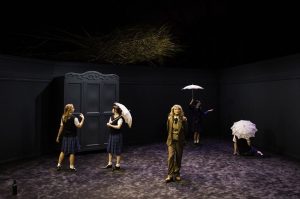Malthouse Theatre, Southbank
Reviewed on March 2, 2016

It seems almost shocking that the timeless Australian classic, Picnic at Hanging Rock, recently celebrated its fortieth anniversary. The first major directorial effort by Peter Weir, this iconic motion picture was closely- based on author, Joan Lindsay’s haunting and ethereal novella.
Set at the turn of the twentieth century on the cusp of Federation, Picnic at Hanging Rock slowly unfolds with three girls and their teacher from an exclusive private school, going missing in rural Victoria on St. Valentine’s Day. After an extensive and desperate search by local townsfolk and the police, only one of the girls is eventually found.
The mysterious atmosphere is further highlighted by Russell Boyd’s striking photography, Judith Doorman’s delicate costume design, and Gheorghe Zamfir’s breathtaking pan pipe soundtrack.
Upon release, the film created immediate fervour with local and international audiences. Picnic at Hanging Rock’s smart production values appeared so historically ingrained, many viewers believed that the story was based on actual events.
The movie also become a touchstone for shaping our national identity overseas, as well as helping to rebuild Australia’s long – dormant motion picture industry in the process.
There has been a recent trend of adapting famous films for the stage. Some ambitious examples include Brief Encounter, Mary Poppins, Ghost – The Musical, and North by Northwest.
Brief Encounter and North by Northwest in particular, were almost literal scene by scene readings of each movie, successfully integrating small and large scale props for dramatic and comic effect.
As part of their 2016 line up, the Malthouse Theatre’s premiere of Picnic at Hanging Rock, could not be more different from the above-mentioned shows.
Expanding on both Linsday’s foreboding book and the film’s seamless fluidity, the Malthouse team of Tom Wright (playwright), Matthew Lutton (direction), Zoe Atkinson (set & costumes), Paul Jackson (lighting), Ash Gibson Greig (composition), and J. David Franzke (sound) have created a striking and piquant theatrical journey.
Dripping with stark symbolism not unlike Charles Blackman’s Schoolgirl series of paintings come to life, the company’s hypnotic and filmic re-imagining almost takes place inside the mind of a David Lynch, John Wyndham, Henry James or Stanley Kubrick. Even the most minor detail seems controlled, if not at the mercy of a higher presence.
Atkinson’s deceptively simple yet hard-angled charcoal grey set makes oblique reference to The Bermuda Triangle. The popular theory being, that Hanging Rock is actually a portal to a parallel universe. This notion is potentially underscored by an oversized prop wardrobe at the rear of the stage, with triple doors leading into Narnia’s mythical and sinister children’s playground.
The show’s percolating sense of evil is further highlighted by the thick nest of trees suspended over the space. Also, though we never see the titular rock, whether referenced inside the void or in the distance, it is still an omnipotent presence.
Picnic at Hanging Rock’s biggest talking point may be its brilliant use of quick black outs between scenes.
Timed to the second, they add to the shape-shifting time scape the show takes great pains to build. (Tia Clark and Lyndie Li Wan Po must be commended for their choreographically challenging stage management.)
Taking all of the above technical elements into consideration, one cannot help but be drawn in.
Finally, the quintet of Harriet Gordon-Anderson, Arielle Gray, Amber McMahon, Elizabeth Nabben, and Nikki Shiels, move with ease from the Greek chorus – inspired opening prologue, to playing all of the major parts once the story proper clicks into gear.
All five tackle multiple female (and male) roles for the ninety – minute duration with equally immersive success. Without giving too much away, the creative choice of using a woman – only cast gives McMahon’s major character in particular, a massive pay off for the audience by the close of the show.
To enjoy the experience at its fullest, one may need to have read the book, seen the film or at least know some key background details. Otherwise, this is an outstanding new piece of theatre not to be missed.
Image Source: Malthouse Theatre
